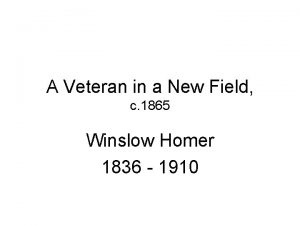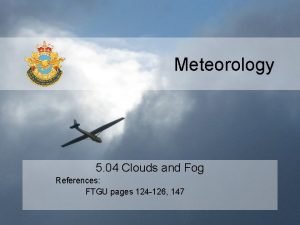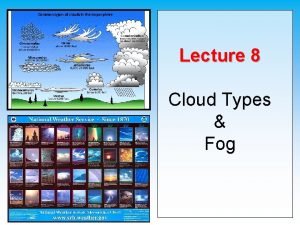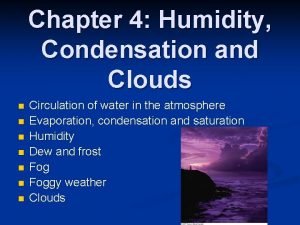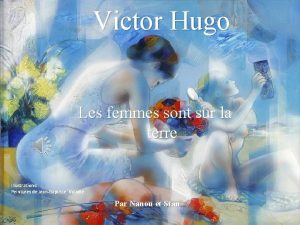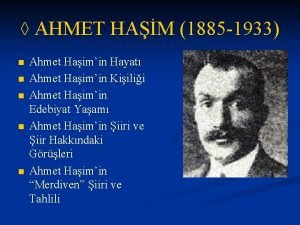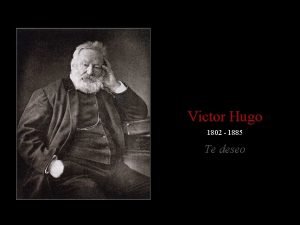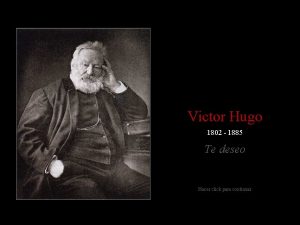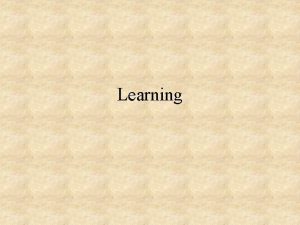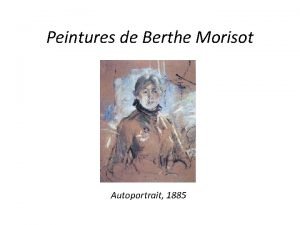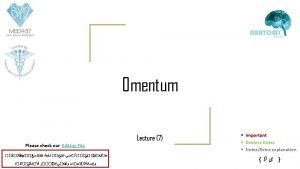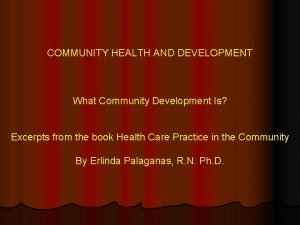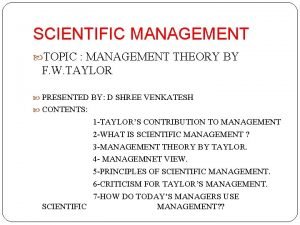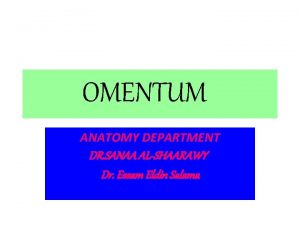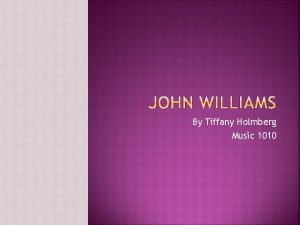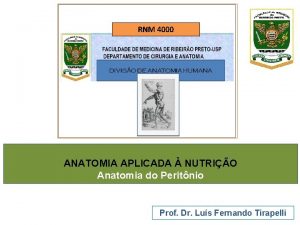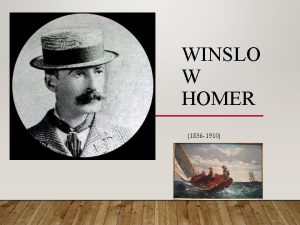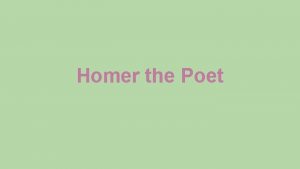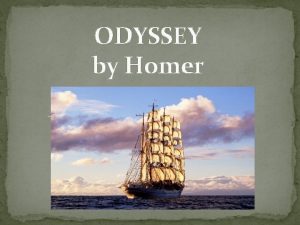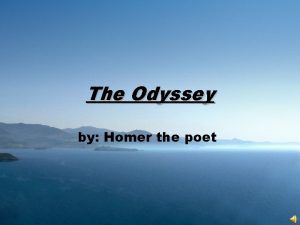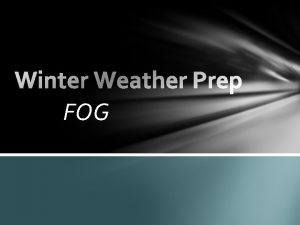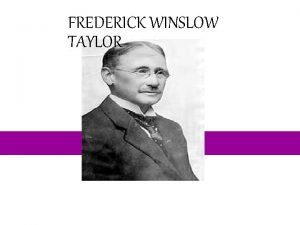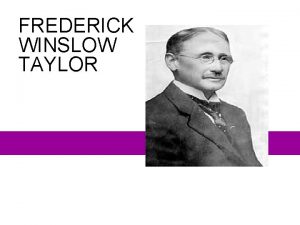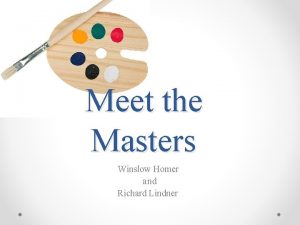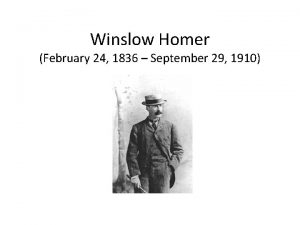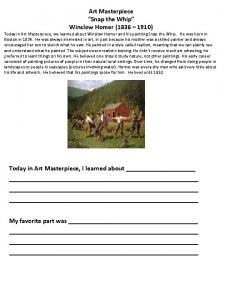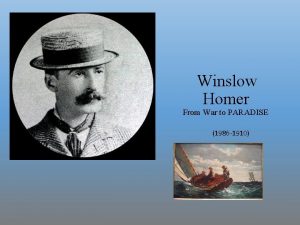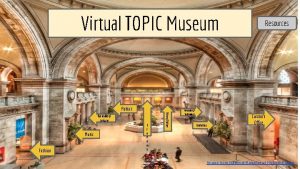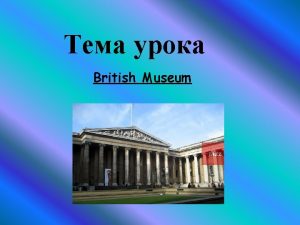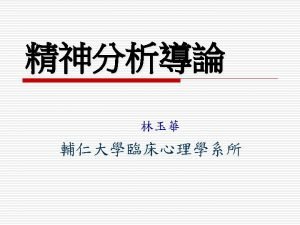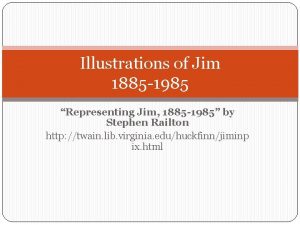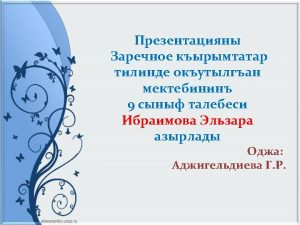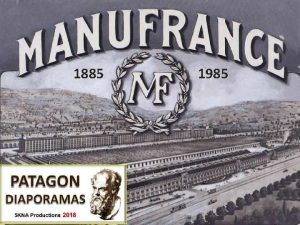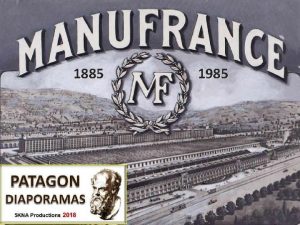Winslow Homer The Fog Warning 1885 Museum of






















- Slides: 22

Winslow Homer, The Fog Warning, 1885, Museum of Fine Arts, Boston, US. Walt Whitman & Emily Dickinson Performer - Culture & Literature Marina Spiazzi, Marina Tavella, Margaret Layton © 2012

Walt Whitman & Emily Dickinson 1. Walt Whitman: life • He was born in New York into a working-class family in 1819. • He had little formal education. • At eleven he started to work as an office boy and then became a printer’s apprentice for a local newspaper. Walt Whitman • He became a journalist supporting radical democratic causes. Performer - Culture & Literature

Walt Whitman & Emily Dickinson 1. Walt Whitman: life • He travelled widely through his country. • He acquired a self-taught culture including the Bible, Homer, Dante, Shakespeare, Carlyle, Goethe, Hegel, Emerson, oriental religion and philosophy. • In 1855 he published the first edition of Leaves of Grass. • Walt Whitman Nine editions followed, each containing new poems. Performer - Culture & Literature

Walt Whitman & Emily Dickinson 1. Walt Whitman: life Performer - Culture & Literature • The third one, in 1860, aroused the indignation of puritanical readers and gained Whitman a reputation for obscenity and homosexuality. • During the Civil War he visited wounded soldiers in the army hospitals. • He continued to believe in the value of democracy and technological progress.

Walt Whitman & Emily Dickinson 1. Walt Whitman: life Performer - Culture & Literature • The fourth edition of Leaves of Grass (1867) contained poems on the Civil War and on the death of President Lincoln. • In 1873 he retired to Camden, New Jersey, where he was visited by admirers and disciples. • He died in 1892.

Walt Whitman & Emily Dickinson 2. Walt Whitman: his influence • Whitman’s popularity in Europe grew in the 1870 s, especially appreciated by the Aesthetic Movement. • He influenced later poets such as Ezra Pound, Carl Sandburg, and, more recently, the Beat Generation. • He is generally regarded as the father of American poetry, as the first voice that was distinctly new and ‘American’. Performer - Culture & Literature

Walt Whitman & Emily Dickinson 3. Leaves of Grass (1855) • Published on 4 th July American Independence Day • Included a preface where the author introduced the subject matter, the language and the aim of his poetry. • Not a collection of poems but a life-long poem. Walt Whitman Performer - Culture & Literature

Walt Whitman & Emily Dickinson 3. Leaves of Grass (1855) • A total of nine different editions published between 1855 and 1892. • Implied a process of development and expansion resulting from a transcendental sense of the unity of all things. • All of life and experience, reality itself, were a process, a continuing, all-embracing flow. Performer - Culture & Literature

Walt Whitman & Emily Dickinson 4. Themes of Whitman’s poetry • Optimism and romantic faith in the dynamic future of the American nation. • Democracy and the ‘American dream’. • The self-celebration of the poet as a prophet of his country. • The dignity of the individual, conceived as the unity of body and soul. Performer - Culture & Literature

Walt Whitman & Emily Dickinson 5. Song of Myself In Song of Myself Whitman divided his being into three. • Myself Whitman’s poetic personality • Me self Whitman’s inner personality • My soul An enigma, unexpected otherness Performer - Culture & Literature

Walt Whitman & Emily Dickinson 5. Song of Myself celebrates the meeting between • The ‘I’ Whose reality is constantly questioned • The ‘you’ The ‘other’, ‘whoever you are’ Performer - Culture & Literature

Walt Whitman & Emily Dickinson 6. Whitman’s style • Use of free verse. • Long lines where rhythm is determined by the thought or emotion expressed. • Use of accumulation and addition. • The participle often replaces the finite verb. • Use of dialect and common speech. • Few similes and metaphors. Performer - Culture & Literature

Walt Whitman & Emily Dickinson 7. Emily Dickinson: life • She was born into a middleclass Puritan family in Amherst, Massachusetts, in 1830. • Her father, a lawyer and a politician, influenced her emotional development and religious belief. • She received her university education at Mount Holyoke Female Seminary. Performer - Culture & Literature Emily Dickinson

Walt Whitman & Emily Dickinson 7. Emily Dickinson: life • She refused to declare her faith in public, as required by the Puritan tradition. • She interrupted her studies and returned home. • She began a life of seclusion and only wore white clothes as ambiguous emblems of spiritual marriage and singleness. • She never left her father’s house except for some walks in the garden. Performer - Culture & Literature Emily Dickinson

Walt Whitman & Emily Dickinson 7. Emily Dickinson: life • She died in 1886. • Poems by Emily Dickinson appeared in 1890 published by the literary critic Thomas W. Higginson. • A complete edition of her poems appeared in 1955, edited by Thomas Johnson. • A collection of her letters was published in 1958. Performer - Culture & Literature

Walt Whitman & Emily Dickinson 8. Influences on Dickinson • The Bible, Shakespeare, Milton, the Metaphysical poets. • Contemporary writers like Emily Brontë. • The Puritan tradition. • Emerson’s Transcendentalism. Performer - Culture & Literature The Homestead, East Facade

Walt Whitman & Emily Dickinson 9. Dickinson vs. Whitman Emily Dickinson • The poet of what is broken and absent. • Detached from contemporary taste, from the great events and contrasts of the age. • Poetry of isolation. • Used her poetry to challenge received certainties. Performer - Culture & Literature Walt Whitman • The poet of wholeness. • Deeply interested and involved in the issues of his time. • Poetry of celebration. • His task was to respond to the spirit of his country, to give voice to the common man.

Walt Whitman & Emily Dickinson 10. Themes in Dickinson’s poetry • • Death and loss. Love and desire. Time. Fear, sorrow and despair. God. Nature. Man’s relation to the universe. Performer - Culture & Literature

Walt Whitman & Emily Dickinson 11. The theme of death Death from the point of view of: • the person dying; • a witness. Death the great mystery, connected with eternity, a liberation from anxiety. Death the place where the human being tends to, in order to become one with the universe. Performer - Culture & Literature

Walt Whitman & Emily Dickinson 12. The theme of love Love is explored through a full range of emotions: • from ecstatic and sensual celebration • to the despair due to separation. • Love expectation of eternity as the hope of a final spiritual union. Performer - Culture & Literature

Walt Whitman & Emily Dickinson 13. The theme of nature Different from man: a source of wonder or fear. Can be presented: • through an objective description; • by juxtaposing the thing observed and the soul of the observer the natural datum leads to philosophical speculation; • as a source of imagery to emphasise an abstract concept or theme. Performer - Culture & Literature

Walt Whitman & Emily Dickinson 14. Dickinson’s style • Poems do not have a title. • Short poems, organised in simple quatrains. • Use of monosyllabic words. • Terms from various sources: law, geometry, engineering. • Use of rhetorical devices such as imperfect rhymes, assonance, alliteration, paradox, metaphor, ellipsis and capitalisation. • Extensive use of dashes. Performer - Culture & Literature
 Winslow homer veteran in a new field
Winslow homer veteran in a new field Precipitation induced fog
Precipitation induced fog How fog is formed
How fog is formed Advection fog vs radiation fog
Advection fog vs radiation fog What are characteristics of impressionism
What are characteristics of impressionism 7 octobre 1885
7 octobre 1885 Britan
Britan Les femmes sont sur la terre... victor hugo (1802-1885) ...
Les femmes sont sur la terre... victor hugo (1802-1885) ... Grinnall scorpion 3
Grinnall scorpion 3 Merdiven şiirinin tahlili
Merdiven şiirinin tahlili Desejo victor hugo poema
Desejo victor hugo poema Impressionism characteristics
Impressionism characteristics Te deseo victor hugo poema
Te deseo victor hugo poema Ebbinghaus 1885
Ebbinghaus 1885 Autoportrait
Autoportrait Foramen of winslow boundaries
Foramen of winslow boundaries Importance of community health nursing
Importance of community health nursing Bahasa inggris kesehatan masyarakat
Bahasa inggris kesehatan masyarakat F.w. taylor contribution to management
F.w. taylor contribution to management Greater sac
Greater sac Samantha winslow
Samantha winslow John williams barbara ruick
John williams barbara ruick Mesenterio
Mesenterio
